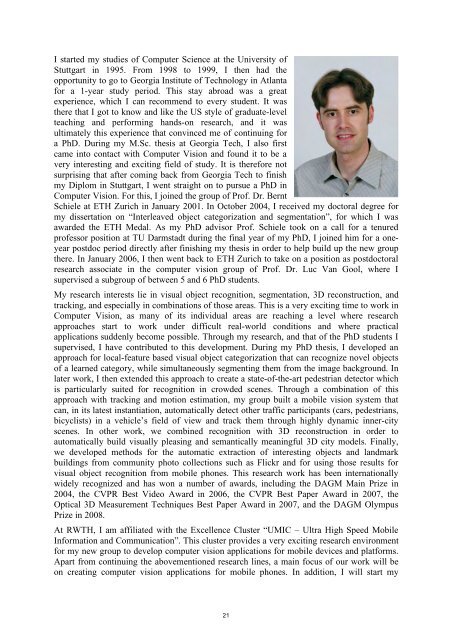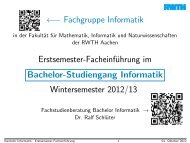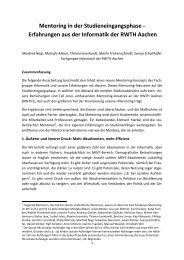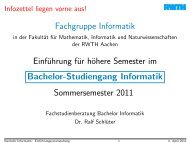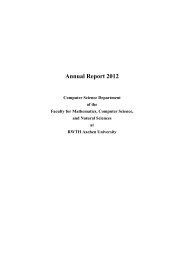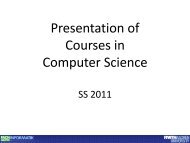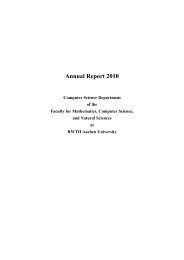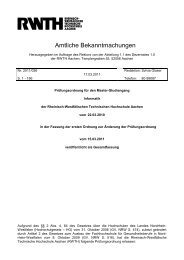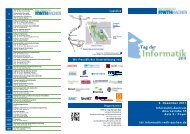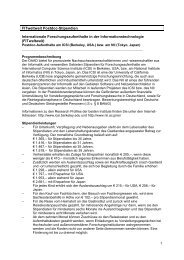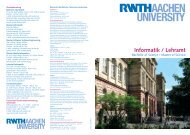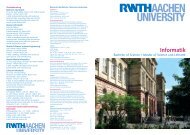- Page 1 and 2: Annual Report 2007/2008 Computer Sc
- Page 3 and 4: Contents Preface...................
- Page 5 and 6: Preface This report provides a summ
- Page 7: Faculty Life 3
- Page 10 and 11: The afternoon programme was closed
- Page 12 and 13: InfoCup 2007 and InfoCup 2008 by So
- Page 14 and 15: 4ING Conference and Common Plenary
- Page 16 and 17: Dinner Speech Mind moves Matter - T
- Page 18 and 19: Invited Speaker Christian Jensen fr
- Page 20 and 21: Moreover, all conference attendees
- Page 22 and 23: Paolo Bientinesi In June 2008 I joi
- Page 26 and 27: teaching this winter semester with
- Page 29 and 30: Description of the contents and cur
- Page 31 and 32: knowledge-representations and cogni
- Page 33 and 34: Required Qualifications Multifacete
- Page 35 and 36: Description of the contents and cur
- Page 37 and 38: will always be on knowledge transfe
- Page 39 and 40: The International Master Programme
- Page 41 and 42: General Description of the Programm
- Page 43 and 44: The Girls’ Day is organized natio
- Page 45 and 46: Bischof, Kuhlen, Schirski Praktikum
- Page 47 and 48: Ney Arbeitsgemeinschaft Spracherken
- Page 49 and 50: Grädel, Berwanger Mathematische Lo
- Page 51 and 52: Jarke, Quix, Chatti, Li Implementat
- Page 53 and 54: Thomas, Löding, Karianto, Radmache
- Page 55 and 56: Bücker, Vehreschild, Hauptstudium)
- Page 57 and 58: Seidl Lehrstuhlseminar AG (2) Seipo
- Page 59 and 60: 30.01.2008: Ein Systematischer Entw
- Page 61 and 62: Last Name First Name Title of Thesi
- Page 63 and 64: Last Name First Name Title of Thesi
- Page 65 and 66: Last Name First Name Title of Thesi
- Page 67 and 68: Last Name First Name Title of Thesi
- Page 69 and 70: Last Name First Name Title of Thesi
- Page 71 and 72: Media Informatics Last Name First N
- Page 73 and 74: Number of Students: Beginners and O
- Page 75:
Diplomas per Year 180 160 140 120 1
- Page 79 and 80:
Staff • Faculty • Secretary Alg
- Page 81 and 82:
Overview The group focusses both in
- Page 83 and 84:
e tackled theoretically, practicall
- Page 85 and 86:
Probabilistic Analysis of Discrete
- Page 87 and 88:
Other Activities Courses Our group
- Page 89 and 90:
Talks and Publications Talks Heiner
- Page 91 and 92:
Heiko Röglin: Convergence in Conge
- Page 93 and 94:
Staff Theoretical Computer Science
- Page 95 and 96:
Research Projects Algorithms with R
- Page 97 and 98:
Recognizing Probe Graphs Ling-Ju Hu
- Page 99 and 100:
Other Activities Courses Our group
- Page 101 and 102:
Hans-Joachim Böckenhauer, Juraj Hr
- Page 103 and 104:
• Diploma/Master Students Lars He
- Page 105 and 106:
Overview The years 2007 and 2008 ha
- Page 107 and 108:
PROJECT: QUPES: Verification of Qua
- Page 109 and 110:
Markov chains. The goal is to devel
- Page 111 and 112:
Schorr-Waite traversal algorithm. O
- Page 113 and 114:
The MOVES Group is currently workin
- Page 115 and 116:
Other Activities J.-P. Katoen • M
- Page 117 and 118:
Joost-Pieter Katoen: Perspectives i
- Page 119 and 120:
Henrik Bohnenkamp, Holger Hermanns,
- Page 121 and 122:
Thomas Noll, and Stefan Rieger: Com
- Page 123 and 124:
Martin Plücker Matthias Raffelsiep
- Page 125 and 126:
Research Projects AProVE: Automatic
- Page 127 and 128:
Satisfiability Checking for Termina
- Page 129 and 130:
Other Activities J. Giesl • Edito
- Page 131 and 132:
• Participant of the 9th Internat
- Page 133 and 134:
Lehrstuhlseminar, RWTH Aachen, Augu
- Page 135 and 136:
J. Giesl (ed.). Proceedings of the
- Page 137 and 138:
Staff Software Engineering • Facu
- Page 139 and 140:
Overview The research activities of
- Page 141 and 142:
Research Projects Semantical Suppor
- Page 143 and 144:
at supporting the engineers in deve
- Page 145 and 146:
cooperation with our industrial par
- Page 147 and 148:
parameters, which take another type
- Page 149 and 150:
covers the prototype for our corres
- Page 151 and 152:
(Member of the PC); Fujaba Days 200
- Page 153 and 154:
Körtgen, A.: Transferprojekt T5 -
- Page 155 and 156:
Chemical Engineering. From Understa
- Page 157 and 158:
Nagl, M.: Process/Product Model: St
- Page 159 and 160:
Staff Software Construction • Fac
- Page 161 and 162:
Research Projects Model-Based Engin
- Page 163 and 164:
depicts the relations between the s
- Page 165 and 166:
Process Assessment based on Softwar
- Page 167 and 168:
Talks and Publications Talks H. Lic
- Page 169 and 170:
Staff Communication and Distributed
- Page 171 and 172:
Overview Research focuses on design
- Page 173 and 174:
signaling load in a core IMS networ
- Page 175 and 176:
Anonymous Communication Alexis Pime
- Page 177 and 178:
A set of empirical studies will foc
- Page 179 and 180:
esearch is to address the problem o
- Page 181 and 182:
However, in real life due to high a
- Page 183 and 184:
Publications Andersson, C.; Martucc
- Page 185 and 186:
Jakobs, K.; Blind, K.: Co-ordinatio
- Page 187 and 188:
Proceedings of the 10th ACM Interna
- Page 189 and 190:
Thomas Jansen Hakan Karahan Johanne
- Page 191 and 192:
Research Projects A Flexible and Ve
- Page 193 and 194:
The challenges in terms of communic
- Page 195 and 196:
paths and multicast groups is essen
- Page 197 and 198:
We focused our attention on polynom
- Page 199 and 200:
Enhancing the Quality of VoIP with
- Page 201 and 202:
Other Activities P2P ‘08 From the
- Page 203 and 204:
At its core, the book covers modeli
- Page 205 and 206:
Talks and Publications Talks Klaus
- Page 207 and 208:
Olaf Landsiedel, Hamad Alizai, Klau
- Page 209 and 210:
Staff Informatik 5 Information Syst
- Page 211 and 212:
Overview Informatik 5 represents th
- Page 213 and 214:
Research Projects UMIC: Ultra High-
- Page 215 and 216:
Body Posture Respiration Movement P
- Page 217 and 218:
database technologies for the manag
- Page 219 and 220:
Teachers and students from Cairo Un
- Page 221 and 222:
aiXPerience software environment fo
- Page 223 and 224:
Dr. R. Klamma is a substitute membe
- Page 225 and 226:
tember 2007. He was chair of the or
- Page 227 and 228:
Y. Cao: A Toolkit to Support Dynami
- Page 229 and 230:
D. Kensche: Generic Schema Mappings
- Page 231 and 232:
D. Schmitz: Modellbasierte Anforder
- Page 233 and 234:
Graz, Austria, September 3-5, 2008,
- Page 235 and 236:
S. Becker, M. Heller, M. Jarke, W.
- Page 237 and 238:
D.Dugosija, V.Efe, S.Hackenbracht,
- Page 239 and 240:
Data Management (MDM 2008), Beijing
- Page 241 and 242:
C. Seeling, W. Prinz, A. Becks: Tra
- Page 243 and 244:
Staff • Faculty Knowledge-Based S
- Page 245 and 246:
Research Projects A Deliberative Re
- Page 247 and 248:
In the last three years we continuo
- Page 249 and 250:
eamformer module was developed whic
- Page 251 and 252:
The idea is that already developed
- Page 253 and 254:
RoboCup 2007. We participated with
- Page 255 and 256:
Publications Jens Claßen, Patrick
- Page 257 and 258:
Human Language Technology and Patte
- Page 259 and 260:
Overview The ‘Lehrstuhl für Info
- Page 261 and 262:
At ‘Lehrstuhl für Informatik 6
- Page 263 and 264:
• Methods for unsupervized traini
- Page 265 and 266:
Examples from the USPS database Sig
- Page 267 and 268:
DFG Project Statistical Modelling f
- Page 269 and 270:
manager is realized with a pipeline
- Page 271 and 272:
Quaero Quaero is a collaborative re
- Page 273 and 274:
T. Deselaers, T. Gass, T. Weyand, a
- Page 275 and 276:
T. Gass, T. Weyand, T. Deselaers, a
- Page 277 and 278:
of the Cross Language Evaluation Fo
- Page 279 and 280:
Y. Zhang, R. Zens, and H. Ney. Impr
- Page 281 and 282:
Overview The research area of the g
- Page 283 and 284:
models, following the “Feferman-V
- Page 285 and 286:
y these systems, as well as their a
- Page 287 and 288:
• Member of the Steering Committe
- Page 289 and 290:
F. Radmacher: An Automata Theoretic
- Page 291 and 292:
In Proceedings of the 6th Internati
- Page 293 and 294:
Staff • Faculty Mathematical Foun
- Page 295 and 296:
Recently, substantial progress has
- Page 297 and 298:
(1) to achieve a systematic classif
- Page 299 and 300:
T. Ganzow, Order-invariant MSO is s
- Page 301 and 302:
A. Dawar and E. Grädel. The Descri
- Page 303 and 304:
• Student Researchers: Shakeeb Ah
- Page 305 and 306:
We are exploring these applications
- Page 307 and 308:
Reverse engineering and feature rec
- Page 309 and 310:
A dynamic morphable face model Domi
- Page 311 and 312:
Geodesic Distance Fields on Triangl
- Page 313 and 314:
Image Selection For Improved Multi-
- Page 315 and 316:
Offset Surface Generation for Polyg
- Page 317 and 318:
Global Parametrization with Orienta
- Page 319 and 320:
City-Scale 3D Reconstruction Gregor
- Page 321 and 322:
Other Activities Committees and Org
- Page 323 and 324:
• Director of the Steinbeis Trans
- Page 325 and 326:
2008: L. Kobbelt, M. Botsch: ITMAN
- Page 327 and 328:
M. Habbecke, L. Kobbelt: A Surface-
- Page 329 and 330:
Data Management and Exploration Sta
- Page 331 and 332:
• Lecture on “Index structures
- Page 333 and 334:
query processing they do not facili
- Page 335 and 336:
e designed in such a way that each
- Page 337 and 338:
Relevance Feedback Christian Beecks
- Page 339 and 340:
Data streams are ubiquitous in mobi
- Page 341 and 342:
• Int. Conf. on Extending Data Ba
- Page 343 and 344:
Wichterich M., Beecks C., Seidl T.:
- Page 345 and 346:
Emmanuel Müller: Subspace Clusteri
- Page 347 and 348:
• Diploma-, Master-, and Secondar
- Page 349 and 350:
MINT subjects have been granted to
- Page 351 and 352:
SAiL-M: semi-automatic analysis of
- Page 353 and 354:
portals or software. Such an adapte
- Page 355 and 356:
students’ learning progress. To a
- Page 357 and 358:
Anna Dyckhoff • Co-organization o
- Page 359 and 360:
U. Schroeder: The integrated eLearn
- Page 361 and 362:
Giesserei - Die Zeitschrift für Te
- Page 363 and 364:
Anna Koster, Henning Kiel, Sarah Me
- Page 365 and 366:
including Stanford University, KTH
- Page 367 and 368:
wall displays distributed around th
- Page 369 and 370:
DRAGON: A Direct Manipulation Inter
- Page 371 and 372:
Common systems for PIM fail because
- Page 373 and 374:
modular low-level architecture that
- Page 375 and 376:
Other activities We hosted the seco
- Page 377 and 378:
Mei-Fang Liau, Jonathan Diehl, and
- Page 379 and 380:
Sven Kratz and Rafael Ballagas. Ges
- Page 381 and 382:
Dipl.-Inform. Daniel Merschen Dipl.
- Page 383 and 384:
Adaptive Protocol Stacks and Model
- Page 385 and 386:
important factor in embedded system
- Page 387 and 388:
ZAMOMO is a BMBF-funded project dea
- Page 389 and 390:
Publications J. Beckers, D. Klünde
- Page 391 and 392:
D. Schmitz, P. Drews, F. Hesseler,
- Page 393 and 394:
Overview A recurring theme of the r
- Page 395 and 396:
Research Projects Over the past yea
- Page 397 and 398:
Reliable Parameter Estimation for R
- Page 399 and 400:
Other Activities Our institute take
- Page 401 and 402:
Talks and Publications Talks M. Pet
- Page 403 and 404:
Mathematik und Informatik, Ernst-Mo
- Page 405 and 406:
Computational Engineering Science -
- Page 407 and 408:
Overview The focus of our research
- Page 409 and 410:
Adjoint Error Analysis in ICON. Rie
- Page 411 and 412:
Talks and Publications Talks Severa
- Page 413 and 414:
Performance Analysis of Parallel Pr
- Page 415 and 416:
Research Activities Scalable Perfor
- Page 417 and 418:
Virtual Institute - High Productivi
- Page 419 and 420:
Talks and Publications Publications
- Page 421 and 422:
F. Wolf, B. Mohr, J. Dongarra, S. M
- Page 423 and 424:
Overview The Virtual Reality Group
- Page 425 and 426:
Research Projects Interactive Visua
- Page 427 and 428:
eferencing should lead to the estab
- Page 429 and 430:
the visualization. Displaying the v
- Page 431 and 432:
main differences between minimal in
- Page 433 and 434:
Figure 2: Setup of a VR-based fMRI
- Page 435 and 436:
Other Activities As part of the Cen
- Page 437 and 438:
Marc Schirski: Employing Graphics H
- Page 439 and 440:
K. Hack, P. Cerfontaine, E. Fried,
- Page 441 and 442:
Tobias Walter (i3) won the Microsof
- Page 443 and 444:
Dissertations 439
- Page 445 and 446:
Robust Real-Time Localization and M
- Page 447 and 448:
Automatic Presentations of Infinite
- Page 449 and 450:
The results of this thesis are bein
- Page 451 and 452:
Decentralized and View-based Manage
- Page 453 and 454:
Logic and Games on Automatic Struct
- Page 455 and 456:
Statistical Computer-Assisted Trans
- Page 457 and 458:
Semantical Support for Conceptual D
- Page 459 and 460:
Integrated Experience-Based Support
- Page 461 and 462:
Monitoring database concepts for cr
- Page 463 and 464:
Planung und Umsetzung von Geschäft
- Page 465 and 466:
applications. To evaluate the pract
- Page 467 and 468:
Proaktive Assistenz zur kontextabh
- Page 469 and 470:
Information System Support for Tran
- Page 471 and 472:
The DP Framework for Proving Termin
- Page 473 and 474:
Robust Appearance-based Sign Langua
- Page 475 and 476:
Context Management and Personalisat
- Page 477 and 478:
Central Services 473
- Page 479 and 480:
Staff System Administration Group
- Page 481 and 482:
Local Area Network Since 1986 the D
- Page 483 and 484:
1. What you can find in our library
- Page 485 and 486:
• Fitting to the opening of the c
- Page 487 and 488:
Staff Fachschaft Mathematik, Physik
- Page 489 and 490:
Overview The Fachschaft (group of s
- Page 491 and 492:
Co-operations 487
- Page 493 and 494:
TGGS Thai-German Graduate School of
- Page 495 and 496:
Bonn-Aachen International Center fo
- Page 497 and 498:
Overview Cluster of Excellence ”U
- Page 499 and 500:
• Prof. Robert Calderbank, Elect.
- Page 501 and 502:
interaction to the knowledge, inter
- Page 503 and 504:
There is a unit working on foundati
- Page 505 and 506:
• Dipl.-Inform. Arne Schmitz, Cha
- Page 507 and 508:
scheduled for 2009 which is going t
- Page 509 and 510:
Virtual Institute - High Productivi
- Page 511 and 512:
Organisation Board • Univ.-Prof.
- Page 513 and 514:
Foresight-Monitoring The Fraunhofer
- Page 515 and 516:
Contact Daria Adenaw M.A. c/o RWTH
- Page 517 and 518:
Computer Science Technical Reports
- Page 519:
2008-16 Hendrik vom Lehn, Elias Wei


